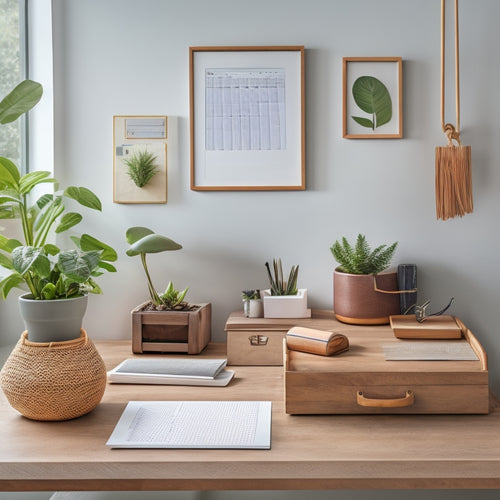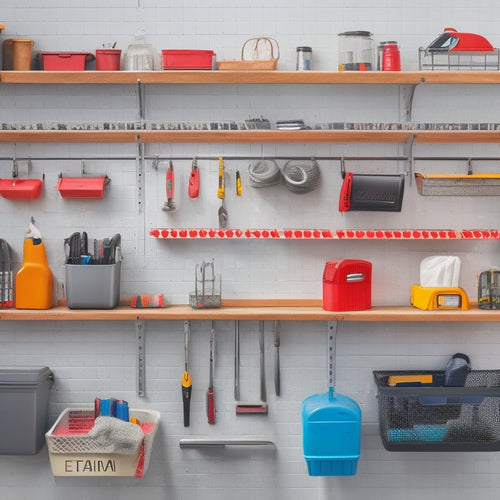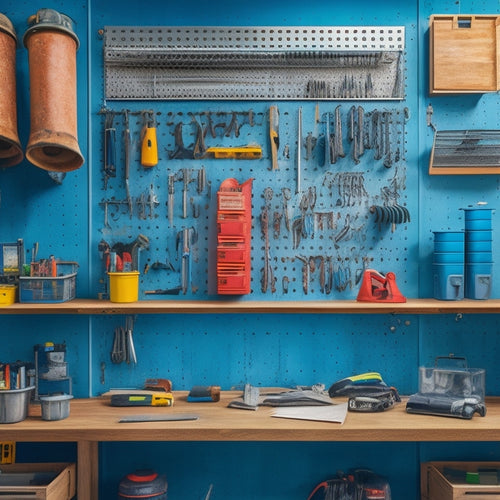
Easy 3-Step DIY Pegboard Installation for Beginners
Share
You're just three steps away from a successful DIY pegboard installation. First, gather essential tools and materials, including a sturdy work surface, tape measure, level, drill, and pegboard. Next, prepare the wall by inspecting for sturdiness, cleaning, and lightly sanding any paint damage. Finally, measure and mark the wall, drill pilot holes, and install hooks, ensuring a level and secure attachment. With these basics covered, you're ready to customize your pegboard and bring order to your workspace - now, take the next step to maximize your pegboard's potential.
Key Takeaways
• Prepare the wall by inspecting for sturdiness, cleaning, and lightly sanding to ensure a strong bond with wall anchors.
• Choose the right pegboard size and material based on your workspace layout, tool collection, and aesthetic preferences.
• Measure and mark the wall accurately, accounting for obstacles and electrical outlets, and use a level to ensure straight installation.
• Drill pilot holes and install anchor screws securely, planning hook placement for efficient organization and tool access.
• Double-check the level and secure attachment to avoid common mistakes, and customize your pegboard with different grid layouts and hooks.
Gathering Essential Tools and Materials
Gather a sturdy work surface, a tape measure, a level, a drill, drill bits, a jigsaw or circular saw (for cutting the pegboard), a sander (optional), and a stud finder to guarantee a secure installation. These Toolbox Essentials will make sure you're well-equipped to tackle the task at hand.
When it comes to Material Sources, you'll need to decide where to buy your pegboard. You can opt for a pre-made pegboard or purchase a pegboard sheet and cut it to size yourself. Home improvement stores like Home Depot or Lowe's typically carry a variety of pegboard options.
Before you head to the store, take stock of the tools you already have in your arsenal. You might be surprised at what you already have on hand. Make a list of what's missing and prioritize those items. Don't be afraid to ask for help or advice from the pros at the store. They can offer valuable insights and recommendations.
With your tools and materials in hand, you'll be ready to move on to the next step: preparing the wall for installation.
Preparing the Wall for Installation
Before you begin drilling holes and hanging your pegboard, take a few minutes to inspect the wall where you plan to install it, making sure it's sturdy enough to hold the weight of your tools and accessories. Check for any cracks, weak spots, or hollow areas that might impact the pegboard's stability. You don't want your pegboard to fall off the wall, damaging your tools or the wall itself.
Next, examine the wall's surface for any imperfections, such as unevenness or old adhesive residue. Clean the wall thoroughly to establish a strong bond between the pegboard and the wall anchors. If you notice any paint damage, lightly sand the area to smooth it out. This will prevent the anchors from slipping or the pegboard from hanging unevenly.
Choosing the Right Pegboard Size
With your wall prepared and ready for installation, you can now focus on selecting the ideal pegboard size to fit your specific needs and available space. Consider the workspace layout and the type of tools you plan to hang. A larger pegboard may be necessary if you have a lot of bulky tools or equipment, while a smaller one might suffice for smaller items.
Next, think about the pegboard material. Will you choose a durable metal pegboard or a more affordable plastic one? Your decision will impact the overall aesthetic and functionality of your workspace.
Make sure to measure the space where you plan to install the pegboard, taking into account any obstacles or constraints. You want to guarantee a seamless fit and easy access to your tools.
Measuring and Marking the Wall
Take precise measurements of the wall space where you'll be installing the pegboard, making sure you account for any electrical outlets, switches, or other obstacles that might affect the board's placement. Use a tape measure to record the width and height of the wall space, taking note of any irregularities or obstructions.
Next, locate the wall studs behind the drywall using a stud finder or by knocking gently on the wall to identify the solid sound of a stud. Mark the spot with a pencil, as you'll want to anchor your pegboard to these sturdy points. Don't forget to check for any plumbing or electrical lines behind the wall before drilling.
Using a leveling tool, draw a level line along the wall to make sure your pegboard is straight. This will prevent any wonky installations that can throw off the entire look.
With your measurements and markings in place, you're now ready to move on to the next step – drilling holes and installing hooks. But for now, take a step back and admire your handiwork – you've successfully measured and marked the wall for a seamless pegboard installation.
Drilling Holes and Installing Hooks
Drill pilot holes into the wall at the marked stud locations, using a drill bit that's slightly smaller than the anchor screws to guarantee a snug fit. This guarantees the screws will hold securely without splitting the wall material.
Next, insert the anchor screws into the pilot holes, making sure they're seated properly.
Now, it's time to install the hooks. Consider your hook placement strategies: space them evenly apart, or group them by tool type. For example, you might dedicate one section to hammers and another to screwdrivers.
When drilling, maintain your drill bit by keeping it clean and dry. A well-maintained drill bit will make the drilling process smoother and more efficient.
As you install each hook, double-check that it's level and securely attached to the wall. Don't overtighten the screws, as this can damage the wall or strip the anchor.
With your hooks in place, you're one step closer to a functional and organized pegboard.
Organizing Tools and Accessories
Now that your pegboard is installed, it's time to organize your tools and accessories.
You'll need to create a system that keeps frequently used items within easy reach, while storing less-used items in a way that's still accessible.
You'll explore three key areas - tool organization systems, effortless storage solutions, and accessory display options - to create a customized arrangement that maximizes your pegboard's potential.
Tool Organization Systems
With a pegboard in place, you'll need a system to organize your tools and accessories, ensuring everything has a designated spot for easy access and efficient storage. This is where a tool organization system comes in, helping you to maximize your workshop's flow and minimize tool clutter.
A well-planned system will keep your tools within reach, saving you time and frustration. Here are some essential components to include:
-
Tool holders: Designate specific holders for frequently used tools, such as hammers, screwdrivers, and pliers.
-
Accessory bins: Use bins and containers to store small items like nuts, bolts, and screws.
-
Hooks and hangers: Utilize hooks and hangers to hang items like cords, hoses, and accessories.
- Labeling system: Implement a labeling system to identify what's stored in each holder, bin, or hook.
Effortless Storage Solutions
You can create effortless storage solutions by categorizing your tools and accessories into groups, such as hand tools, power tools, and fasteners, and then assigning a specific storage spot for each category. This declutter strategy will help you maximize your space and reduce clutter.
| Category | Storage Spot | Space Saver |
|---|---|---|
| Hand Tools | Top-left pegboard section | Hooks for hanging tools |
| Power Tools | Middle pegboard section | Bins for cord storage |
| Fasteners | Bottom-right pegboard section | Small trays for organization |
| Measuring Tools | Top-right pegboard section | Magnetic strips for level storage |
| Accessories | Bottom-left pegboard section | Small baskets for storage |
Accessory Display Options
Six essential accessory display options can elevate your pegboard's organizational capabilities, ensuring that tools and accessories are effortlessly accessible and visually appealing. As you plan your pegboard installation, contemplate incorporating these display options to maximize storage and convenience.
Here are four accessory display options to contemplate:
-
Basket Displays: Hang baskets of varying sizes to store small items like screws, nuts, and bolts. Label each basket for easy identification.
-
Shelf Arrangements: Install shelves of different depths to accommodate larger tools and accessories. This is perfect for storing power tools, sanders, or other bulky items.
-
Hook Stations: Designate areas for hooks to hang items like hammers, saws, or other frequently used tools.
- Bin Organizers: Use bins or containers to store small items like drill bits, screws, or fasteners. Label each bin for easy access.
Common Mistakes to Avoid
Mistakes in pegboard installation can lead to a wobbly, inefficient, or even dangerous setup, so it's crucial to steer clear of common pitfalls that DIYers often encounter. You've got this far, and you don't want to ruin your project with avoidable pegboard pitfalls.
One common installation blunder is failing to level the pegboard. You might think it's no big deal, but an unlevel board can cause your tools to fall, making a mess and potentially causing damage. Make sure you use a level to confirm your board is perfectly horizontal.
Another mistake isn't using the right type of screws or anchors for your wall type. You don't want your pegboard to come crashing down because you used the wrong screws. Take the time to research the appropriate fastening system for your wall type.
Additionally, don't overcrowd your pegboard. You might be tempted to hang as many tools as possible, but this can lead to a cluttered and inefficient workspace. Leave some space between your tools to ensure easy access and visibility.
Tips for Customizing Your Pegboard
Now that you've successfully installed your pegboard, it's time to personalize it to make it truly yours.
You'll want to ponder a few key elements to customize your pegboard and maximize its functionality.
Pegboard Layout Options
You'll typically begin by dividing your pegboard into zones, each dedicated to a specific type of tool or accessory, to maximize functionality and ease of use. This thoughtful approach guarantees you can quickly find what you need, saving you time and frustration.
To create an efficient layout, consider the following pegboard pattern options:
-
Symmetrical pattern: Divide your pegboard into equal sections, creating a mirrored design that's aesthetically pleasing and easy to navigate.
-
Ergonomic design: Organize tools and accessories based on frequency of use, placing the most commonly used items at comfortable heights and distances to reduce strain on your body.
-
Functional zones: Group similar tools together, such as all your woodworking tools in one area or all your automotive tools in another.
- Personalized grid: Create a custom grid that suits your specific needs, taking into account the size and shape of your tools and accessories.
Pegboard Hook Choices
With your pegboard layout in place, it's time to populate it with hooks that will efficiently hold your tools and accessories, allowing you to customize your pegboard to meet your specific needs.
When it comes to choosing hooks, you'll find a variety of styles to suit your requirements. Consider the Hook Style Variations: single-prong, double-prong, and screw-in hooks. Single-prong hooks are perfect for holding small items like pliers and screwdrivers, while double-prong hooks are ideal for larger tools like hammers and wrenches. Screw-in hooks provide extra security for heavy or bulky items.
Think about Accessory Compatibility when selecting hooks. Will you need hooks with a swivel function to accommodate tools with angled handles? Or perhaps hooks with a built-in spring-loaded mechanism to keep your tools organized and within reach? Consider the weight capacity of each hook and the type of tools you'll be hanging.
Pegboard Color Schemes
Select a pegboard color scheme that complements your workshop's aesthetic and enhances tool visibility by opting from a range of options, including bold brights, industrial neutrals, and custom colors.
When it comes to pegboard aesthetics, color psychology plays a significant role in creating an efficient and inviting workspace. A well-chosen color scheme can influence your mood, productivity, and even your ability to quickly locate tools.
Here are some tips to ponder when selecting a pegboard color scheme:
-
Neutral backgrounds like white, gray, or beige can help tools stand out and make them easier to spot.
-
Bright accents like red, orange, or yellow can draw attention to specific tools or areas of your pegboard.
-
Cool tones like blue or green can create a calming atmosphere and reduce eye strain.
- Custom colors that match your workshop's brand or personal style can add a touch of personality to your space.
Safety Precautions to Take
Before starting the pegboard installation, take a few minutes to assess your workspace and eliminate any potential hazards that could cause injury or damage. As a beginner, prioritizing your safety above all else is crucial. Conduct a thorough hazard analysis to identify potential risks, such as loose wires, slippery floors, or heavy objects that could fall.
Personal Protection Checklist
| Hazard | Risk | Prevention |
|---|---|---|
| Flying debris | Eye injury | Wear safety goggles |
| Sharp objects | Cuts and lacerations | Handle tools with care, wear gloves |
| Electrical shock | Electrocution | Make sure cords are secure, avoid water |
Final Touches and Inspection
Now that your pegboard is mounted, it's time to focus on the final touches.
You'll want to tighten all the screws to make certain everything is securely in place.
Next, you'll conduct a final visual check to verify everything is level, plumb, and properly aligned.
Tightening All Screws
Tighten all screws firmly in a star pattern to guarantee even pressure on the pegboard, making sure not to overtighten. You've made it this far, and now it's time to secure everything in place. Remember, a star pattern means tightening one screw a little, then moving to the next one in a diagonal direction.
Here are some key points to keep in mind while tightening:
-
Importance of torque control: Don't apply too much pressure, or you might strip the screws or damage the pegboard.
-
Use a screwdriver with a comfortable grip to avoid fatigue.
-
Work your way around the board in a consistent pattern to maintain even pressure.
- Double-check that all screws are snug but not overtightened.
Final Visual Check
You've secured the pegboard in place, and it's time to step back and visually inspect the installation for any imperfections or adjustments needed. Take a few moments to walk around the pegboard and evaluate its overall appearance. Check if the board is level, plumb, and properly aligned with the surrounding environment. Make certain that all screws and hooks are securely fastened and evenly spaced.
Next, focus on the aesthetic balance of your pegboard. Confirm that the arrangement of tools and accessories creates visual harmony. Adjust the placement of items as needed to achieve a sense of symmetry and coherence. Consider the color scheme, texture, and shape of the tools and the pegboard itself. Guarantee that everything blends together seamlessly, creating a visually appealing installation that reflects your personal style.
Frequently Asked Questions
Can I Use a Pegboard in a Humid or Outdoor Environment?
It's important to make sure your pegboard is moisture-resistant and weather-sealed to thrive in humid or outdoor environments. Look for materials with built-in protection or apply a waterproof coating to prevent damage from the elements.
How Do I Clean and Maintain My Pegboard Over Time?
Did you know that 80% of tool damage is caused by dust accumulation? You'll prevent that by regularly wiping your pegboard with a soft cloth and mild detergent, ensuring your tools stay in top condition and your pegboard remains functional.
Are Pegboards Suitable for Heavy Tools and Equipment?
You'll want to verify the pegboard's load capacity and weight limits to make sure it can handle your heavy tools and equipment; typically, it's recommended to stay within 10-20% of the maximum weight capacity for safe and secure storage.
Can I Install a Pegboard on a Concrete or Brick Wall?
"You'll be thrilled to know that, yes, you can install a pegboard on a concrete or brick wall! Simply grab wall anchors and the right drill bits, and you'll be securely fastening your pegboard in no time, sweetheart!"
Are Pegboards Available in Custom Colors or Designs?
You'll find pegboards in various custom colors and designs to match your unique style! Explore brand options like WallPeg or pegboard.com for inspiration, and get design inspiration from websites like Pinterest or Houzz to create your perfect board.
Related Posts
-

Best Organizing Tools for a Clutter-Free Space
You're on a mission to change your cluttered space into a peaceful oasis, and you're looking for the best organizing ...
-

3 Simple Steps to a Garage Tool Wall You'll Love
To create a garage tool wall you'll love, start by planning the space, taking inventory of your tools, and measuring ...
-

Custom Pegboard Storage for Your Workshop
You're looking to create a custom pegboard storage system that maximizes your workshop's space, enhances productivity...


